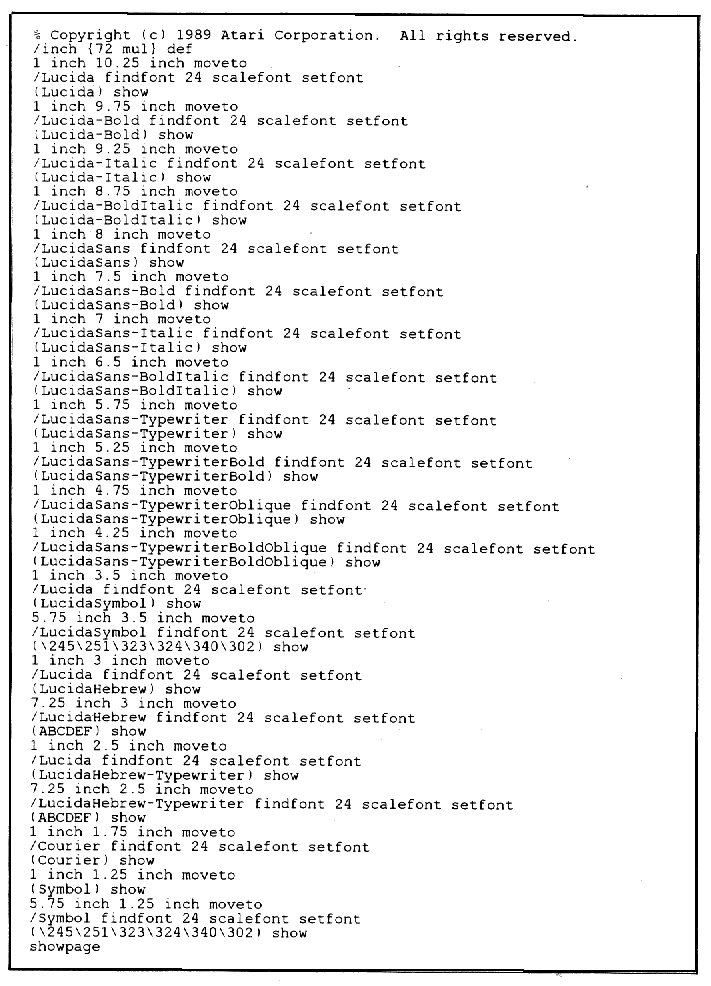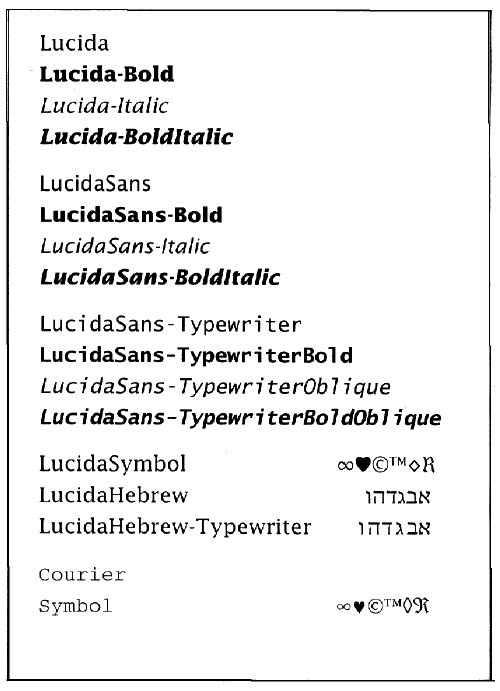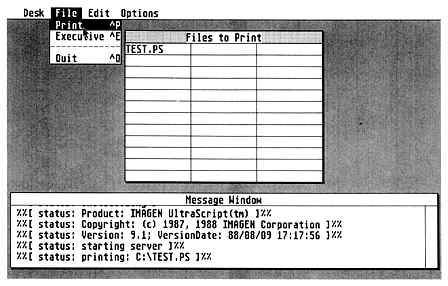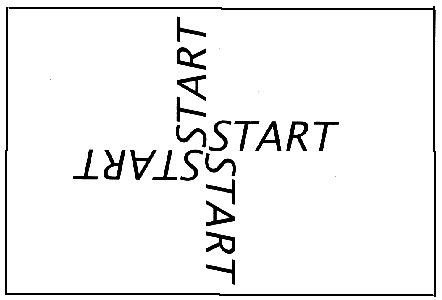UItraScript
Atari's Answer to PostScript Fever
BY ANDREW REESE
START EDITOR
UltraScript-you've heard the name for months and it's finally out. But the question now arises: what is it? It's neither a desktop publishing program, nor a word processor. It's a PostScript interpreter that turns (almost) any Mega/printer combination into a f-a-s-t PostScript printer.
Up to now, if Atari desktop publishers wanted to print PostScnpt files from other computers, it was impossible. The second generation of ST DTP programs can create a PostScript file or print on a PostScnpt device, but until UltraScript, it has been strictly a one-way street.
Enter UltraScript from Imagen. UltraScript can read a PostScript file and output it to an ST-driven printer. It may sound like a glorified printer driver, but you have to understand the background to see its significance.

Figure 1. An example of a PostScript file. These commands are interpreted
by Ultra-Script to create an
image for the printer.
Why PostScript?
PostScript is the creation of Adobe Systems Incorporated of Walnut
Creek, California. It's a unique and specialized programming language whose
sole function is to describe page layouts to "smart" computerized printers.
Adobe pioneered this field and, like Epson printers or DEGAS files, the
pioneer has set the standard for the industry. It has become the DTP buzzword
in the Macintosh and PC worlds. We have some darned good DTP products on
the 16-bit Atari's, but it's been an uphill battle to establish their credibility
outside the ST community without PostScript compatability.

Figure 2. This is a printout of the file shown in Figure 1, as printed
on an
Atari SLM804 laser printer.
There are some very nice aspects of PostScript, however For example, it uses vector fonts that are only defined once and scaled as needed when a page-description requires a specific size. PostScript vector fonts can be scaled smoothly without adding "stair-steps," unlike the bit-mapped ST system fonts. (Vector fonts are also used by ISD/ Ditek's Calamus to achieve the same clean output in any font size.)
An example of a PostScnpt file is shown in Figure 1. When sent to a PostScript printer, these commands are interpreted by the printer's microprocessor to create an image for the printer engine. Figure 2 shows the file from Figure 1 as printed on an Atari SLM804 laser printer.
One reason for the lack of PostScript compatability in the ST world is that it's expensive. Adobe has acted like the true entrepreneurial pioneer it is and has exploited its near-monopoly in this field; developers must pay a pretty penny to use Adobe's PostScript in their programs or printers. For the Atari ST/Mega market, dedicated to "Power Without the Price," these added costs have put full PostScript compatibility out of the reach of most owners.
PostScript printers are also expensive. They need a built-in computer, including a microprocessor with its associated RAM and other circuitry, to turn a Postscript file into a page. Most PostScript printers use either a Motorola 68000 or 68020 microprocessor and a minimum of 512K of expensive DRAM. Since the Atari SLM804 laser printer is a so-called "dumb" printer (no internal microprocessor), its cost is much less. All of the necessary calculations are performed by the ST/Mega's 68000 processor using the computer's RAM. Actually, the Atari system isn't dumb at all-it just doesn't duplicate the computer's capabilities inside the printer.
Imagen's Solution
What Imagen has created is an interpreter that can read and use PostScript
files, just as LDW Power can read and use Lotus 1-2-3 files. But in the
ST/Mega environment, UltraScript converts from PostScript code to finished
page inside the computer and then sends it out to the Atari laser printer
via the DMA port, a very fast and effective method.
Imagen also went to the same font foundries that licensed fonts to Adobe and licensed their own versions for use in UltraScript, thus allowing typeface compatibility with Postscript.

Figure 3. The UltraScript screen. At the top are several drop-down
menus. The large grid is the printer queue list and below it is
the
Message Window. Not much here, but operation of the program is
simplicity itself.
Although well below any Adobe-licensed product in cost, UltraScript is still not cheap by Atari standards, however. The program with its Lucida font family costs $229.95 and additional fonts can cost up to $99.95 each. You can buy Font Sets that reduce this cost considerably, however. The Times, Helvetica and Courier fonts together are available for $129.95 while ITC Book-man, Helvetica Narrow, ITC Zapf Chancery and Dingbats, ITC Avant Garde Gothic and New Century Schoolbook are available for an additional $195.
Other fonts that are available (or should be by the time you read this) include: Optima, Park Avenue, ITC Garamond, ITC Souvenir, ITC Lubalin Graph, ITC Korinna, Univers, Hobo, Brosh Script, Stencil, Helvetica Light and Black, Futura, ITC New Baskerville, Lucida Calligraphy, Eurostile, Cooper Black and Crescendo, an original music font that is compatible with Sonata.
Using UltraScript
We tested the first release version of UltraScript for this review.
It was written to output exclusively to the Atari laser and checks for
it on start-up. If you don't have an SLM804 with this version, forget it-
it's back to the Desktop for you. By the time you read this, however, a
second version should be available that includes support for the Hewlett-Packard
Deskjet, Epson FX, LX, LQ and LQ950 and the IBM Graphics and Pro Printers.
We weren't able to obtain this later version for testing by press time,
but watch for an update in START in the near future.
With an SLM804 connected, however, using UltraScript is simplicity. Imagen recommends use of a hard disk for speed and we concur. It's a big program, over 280K and that means that you need memory-and lots of it. UltraScript requires at least two megabytes of RAM, so you'll need at least a Mega 2 or an ST upgraded to that size or more.
When you start up UltraScript, you see the screen shown in Figure 3. In the top half of the screen is the file queue. In monochrome, you can load up to 36 files for printing, but in color (medium resolution), you're limited to 27 files. That should still be enough for most users, however. In the bottom half of the screen is the message window. Ultra-Script reports on its status here and alerts you to any actions you must take, such as to insert paper for manual feed.
The drop-down menus offer few choices. You can load a file into the queue, delete a file from it or have a file appear more than once. You can also choose manual paper feed from the Options menu or enter the Executive mode. In this mode, you can enter PostScript code directly, but heed the warning in the manual: you had better be intimately familiar with PostScript to make use of Executive mode.
Once you've loaded all the files you want to print into the queue, you just select Print from the File menu and you're off and printing. And the printing is fast-no more going out for a cup of coffee while waiting for a document to print, as with the average PostScript printer.
UltraScript and Timeworks Desktop Publisher ST
Imagen has added one additional fillip to UltraScript. In order to
create a complete PostScript DTP system (probably at Atari's bidding),
Imagen created a PRINTER.SYS file that lets Timeworks' fine DTP program,
Desktop Publisher ST, create Postscript files. The idea is great; the implementation
less so.

Figure 4. The short piece of PostScript code listed in the text
produces this print-out. UltraScript has an Exutive mode that
lets you enter such code directly. It's a convenience designed
for the PostScript professional only.
After you've installed Desktop Publisher ST according to the instructions in the Timeworks and Imagen manuals (PostScript/LaserJet II printer), you copy Imagen's PRINTER.SYS file to your Timeworks folder or disk and overwrite the file of the same name already installed. Then you run FONTWID.APP, as usual.
When you boot Desktop Publisher ST you'll find the Imagen fonts listed in the Font Style/Size menu, instead of the GEM fonts you're used to. Unfortunately, the Timeworks program can't display these fonts on the screen, except as gray bars indicating the size and location of the copy. It's a bit disconcerting to see one's copy treated so cavalierly. Instead of WYSIWYG, it's WYSIHNWYG-What You See Is (Hopefully) Not What You Get.
To add to this inconvenience, you can't print directly from the Timeworks program. When you print, it prints a Postscript file to disk called PUBLISH.PS. Unless you use an accessory utility that lets you change filenames in mid-application, you must exit Timeworks, change the name of the file you created and then re-enter the program to create a second file, If you want to print a file, you have to quit Timeworks again and boot UltraScript. It's all very clumsy, but we probably shouldn't be too harsh on a company who's trying to deliver extra value to its customers. After all, they didn't have to do this at all.
PostScript file and
outputs it to an ST-
driven printer.
If you do manage to work through the Timeworks/UltraScript combination, you will end up with very nice printouts. It's just that it's like taking the long way around the Cape, instead of using the Panama Canal.
Executive Mode
None of us at START are PostScript mavens, but we did experiment with
the Executive mode to make sure that it worked as advertised. There's a
short demo code listing in the manual as follows (slightly modified for
the occasion, of course):
/inch {72 mul} def
/LucidaSans-kalic flndfont 72 scalefont setfont
4 inch 6 inch translate
4{
0 0 moveto
(START) show
90 rotate
} repeat
showpage
The result of this short piece of code (which selects and sets a font and size and then uses a loop to rotate it 90 degrees four times) is shown in Figure 4, photographically reduced. Not bad at all, but we'd hate to try to create a complex page layout this way. Again, it's an extra, so thanks, Imagen, for including it.
The Bottom Line
UltraScript is a joint project by Atari and Imagen, a subsidiary of
QMS, the printer company. The program is copyrighted by Imagen and they
maintain the marketing and support functions. With Imagen's expertise and
experience in printing, coupled with resources matched by few other Atari
publishers, you can expect that the support will be excellent. We're glad
to have them supporting our computers.
When you first open the box, you may feel that you aren't getting your money's worth with UltraScript. There are two double-sided disks containing the program and the Lucida fonts, a slender manual and assorted warranty and order cards. It doesn't look like much, but the value of this program is in the product, not the packaging. The manual tells you everything you need to know in its 40 pages to run UltraScript; it's just not that difficult.
Does it work? Yes, absolutely. Do you need it? Only if you need to print PostScript files on your ST/Mega printer. Is it an important product in the Atari world? We think so. it offers a capability to ST/Mega owners that has been missing over the last three years of the ST's existence.
PRODUCTS MENTIONED
UltraScript, $229.95; Fonts and Font Families,
$99.95-$295. Imagen Corp., P.O. Box 58101, Santa Clara, CA 95052-8101,
(800) 635-3997 or (408) 986-9400.
CIRCLE 160 ON READER SERVICE CARD
Desktop Publisher ST, $129.95. Timeworks, 444 Lake Cook Road,
Deerfield, IL 60015, (312) 948-9200.
CIRCLE 161 ON READER SERVICE CARD